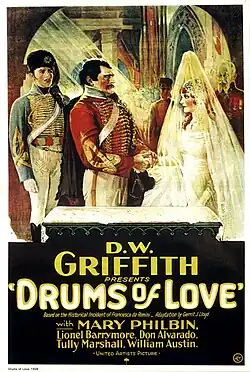Drums of Love
| Drums of Love | |
|---|---|
 Theatrical poster | |
| Directed by | D. W. Griffith |
| Written by | Gerrit J. Lloyd |
| Produced by | D. W. Griffith |
| Starring | |
| Cinematography |
|
| Edited by | James Smith |
| Music by |
|
| Distributed by | United Artists |
Release date |
|
Running time | 100 minutes |
| Country | United States |
| Language | Silent (English intertitles) |
| Budget | $350,000[1] or $505,000[2] |
| Box office | $600,000[2] |
Drums of Love is a 1928 American silent romance film directed by D. W. Griffith starring Mary Philbin, Lionel Barrymore, and Don Alvarado. Two endings, one happy and the other sad, were shot.[3]
Plot
After finding out her father and his estate are in danger, Princess Emanuella saves his life by marrying Duke Cathos de Alvia, a grotesque hunchback. She actually is in love with Leonardo, his attractive younger brother. They already had an affair before the marriage, but continued to meet each other in secret. In the end, Cathos finds out about his wife's unfaithfulness and stabs both his wife and brother to death.[4]
Cast
- Mary Philbin as Princess Emanuella
- Lionel Barrymore as Duke Cathos de Alvia
- Don Alvarado as Count Leonardo de Alvia
- Tully Marshall as Bopi
- William Austin as Raymond of Boston
- Eugenie Besserer as Duchess de Alvia
- Charles Hill Mailes as Duke de Granada
- Rosemary Cooper as the maid
- Joyce Coad as the little sister
Production
The film was a modernized adaptation of a Francesca da Rimini opera. The settings were changed from 14th century Italy to 19th century South America.[5] The film was directed by D. W. Griffith, whose career was in decline.[5] He imposed a happy ending, but this idea was rejected.[5]
The female lead went to Mary Philbin, who was on loan from another studio, Universal Pictures. Cinematographer Karl Struss was especially impressed with the actress and tested her for two weeks with different wigs.[6] Philbin later called working with Griffith a "dream come true."[7]
Reception
The film was received as one of D. W. Griffith's weakest.[5] Critics agreed that Griffith did not know how to handle the film's theme and story the way Tod Browning could have.[8] Both the critics and the audience agreed that the poor reception was mainly due to the ending.[9]
Preservation
Prints of Drums of Love are in the collections of the Library of Congress and George Eastman Museum.[10]
References
- Citations
- ^ "High Cost Films Displeasing Schenck". Variety. December 28, 1927. p. 8.
- ^ a b "Griffith's 20 Year Record". Variety. September 5, 1928. p. 12. Retrieved March 21, 2023.
- ^ Progressive Silent Film List: Drums of Love at silentera.com
- ^ "Drums of Love (1928): (Synopsis)". Turner Classic Movies. Retrieved February 3, 2017.
- ^ a b c d Hall, Mordaunt (2012). "Review Summary". Movies & TV Dept. The New York Times. Archived from the original on October 26, 2012. Retrieved January 15, 2010.
- ^ Slide, Anthony (2010). Silent Players: A Biographical and Autobiographical Study of 100 Silent Film Actors and Actresses. University Press of Kentucky. p. 307. ISBN 978-0-8131-2249-6.
- ^ Beck, Calvin Thomas (1978). Scream Queens: Heroines of the Horrors. Macmillan & Co. p. 70. ISBN 978-0-0250-8170-3.
- ^ Norden 1994, p. 103.
- ^ Norden 1994, p. 104.
- ^ Library of Congress / FIAF American Silent Feature Film Survival Database: Drums of Love
- Works cited
- Norden, Martin F. (1994). The Cinema of Isolation: A History of Physical Disability in the Movies. Rutgers University Press. ISBN 978-0-8135-2103-9.
External links
- Drums of Love at IMDb
- Drums of Love is available for free viewing and download at the Internet Archive